Abstract
We measured plasma nitrate levels and haemodynamics following sublingual glyceryl trinitrate (GTN) (0.5 mg), or isosorbide dinitrate (ISDN) administered intravenously (0.5 mg) or by inhalation (1.25 mg) in 23 patients undergoing cardiac catheterisation for investigation of chest pain. Peak levels were detected at 90 s and 5 min following intravenous and inhaled ISDN respectively and at 3 min following sublingual GTN. Intravenous and inhaled ISDN produced similar plasma levels at 30 s and both were significantly greater than following sublingual GTN. Plasma levels were maintained for longer following inhaled ISDN than intravenous ISDN or sublingual GTN. Haemodynamic responses were qualitatively similar following each treatment; reduction in pulmonary vascular resistance and pressure and left ventricular end diastolic pressure occurred in each group. Heart rate, cardiac output and LV dP/dt.P-1 remained unchanged. Maximal haemodynamic responses were greater following ISDN than GTN, with little difference between the two preparations of ISDN. Haemodynamic responses were more sustained following inhaled ISDN than following sublingual GTN or intravenous ISDN, the latter two being similar in this respect. These findings suggest that inhaled ISDN may provide more rapid and sustained relief from angina than sublingual GTN.
Full text
PDF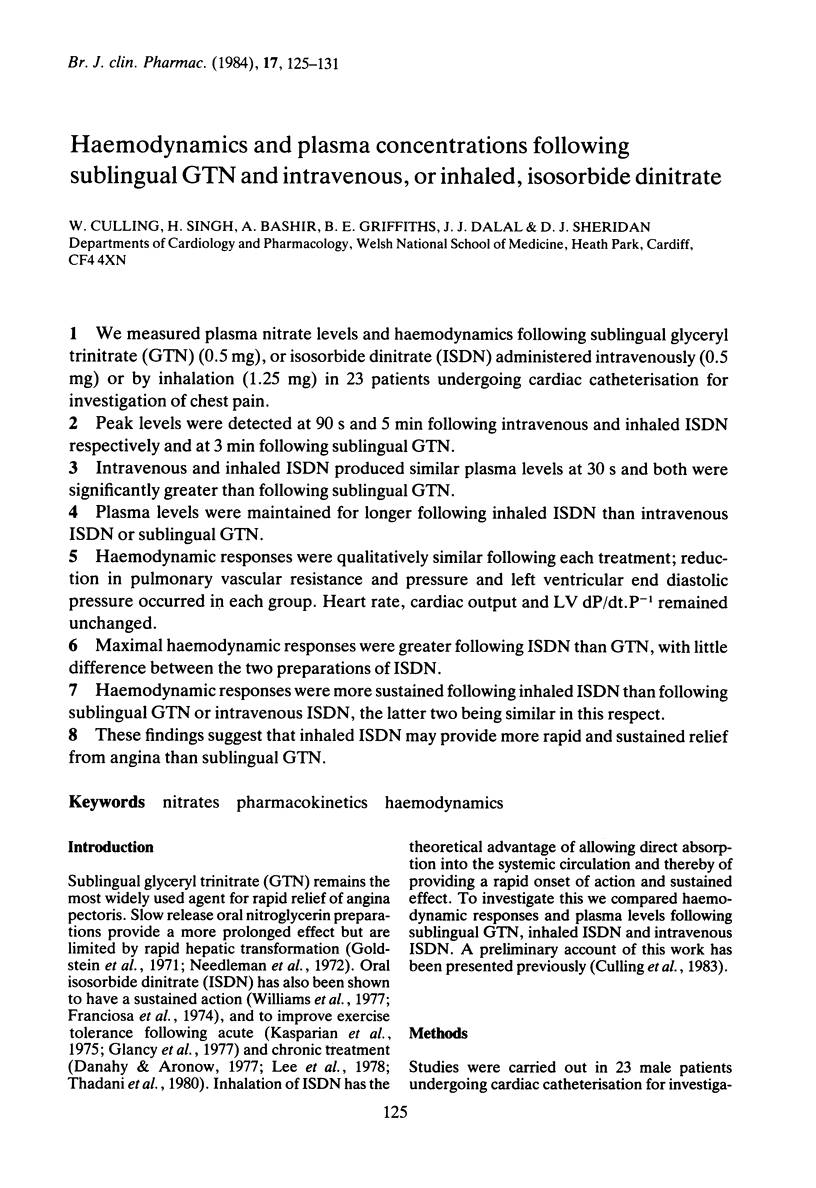
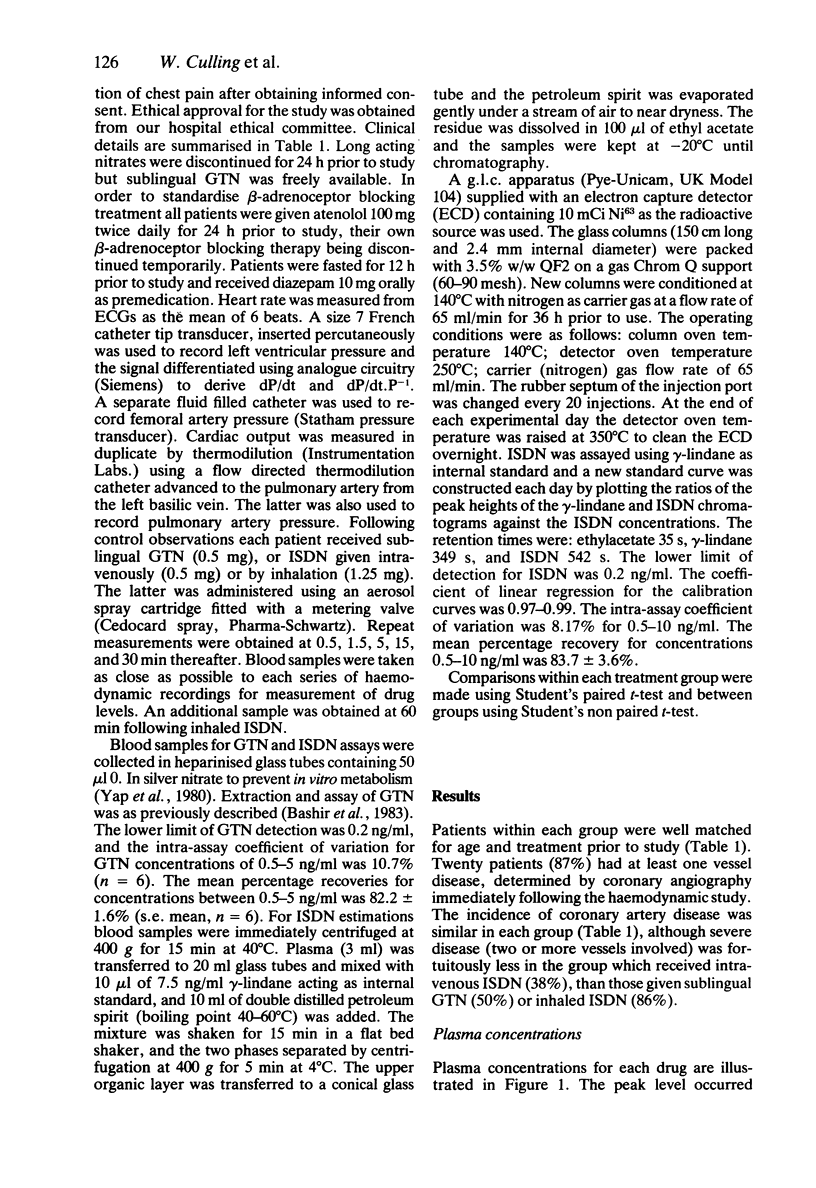
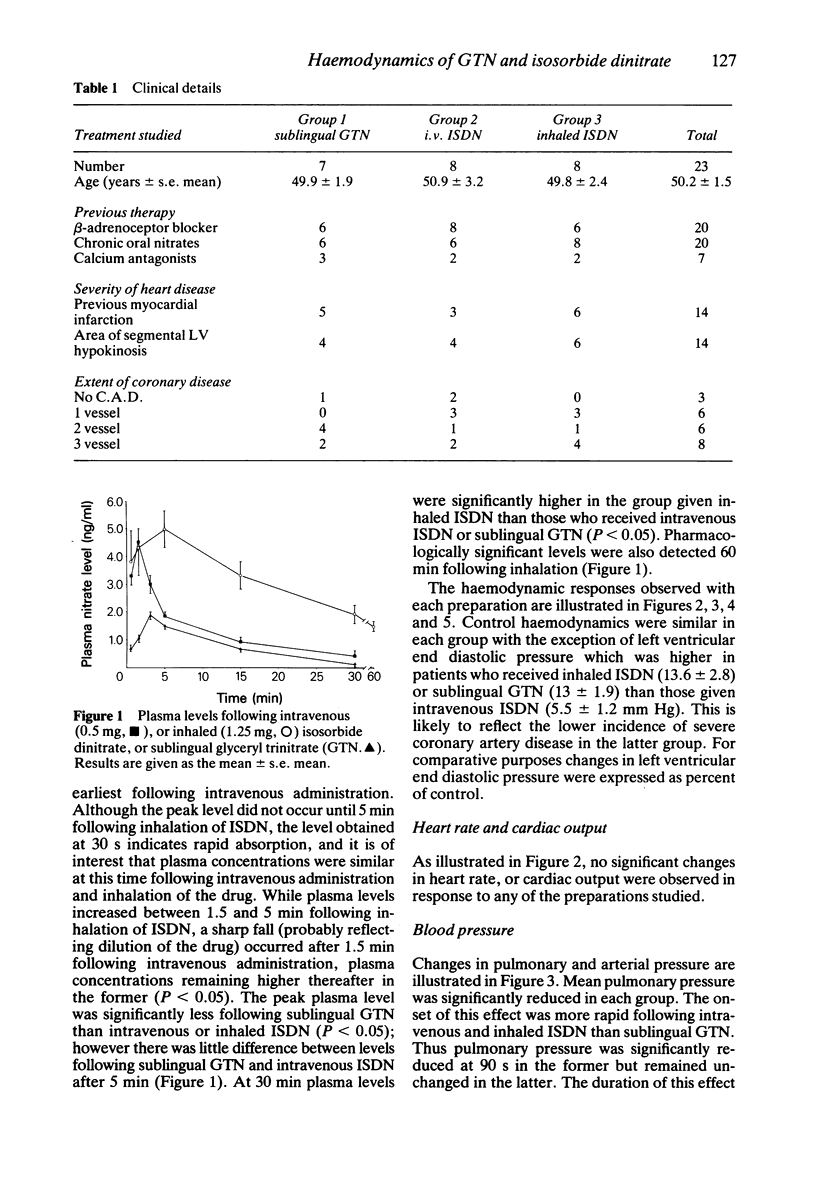
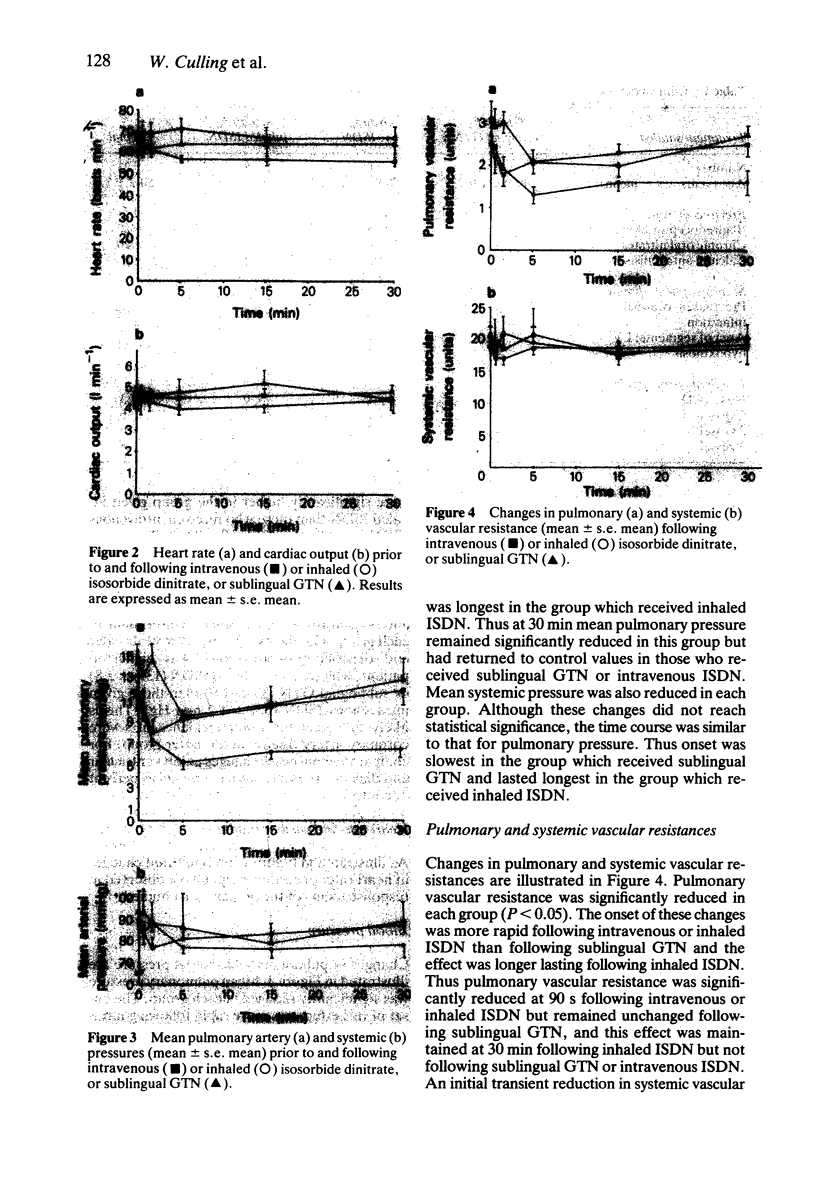
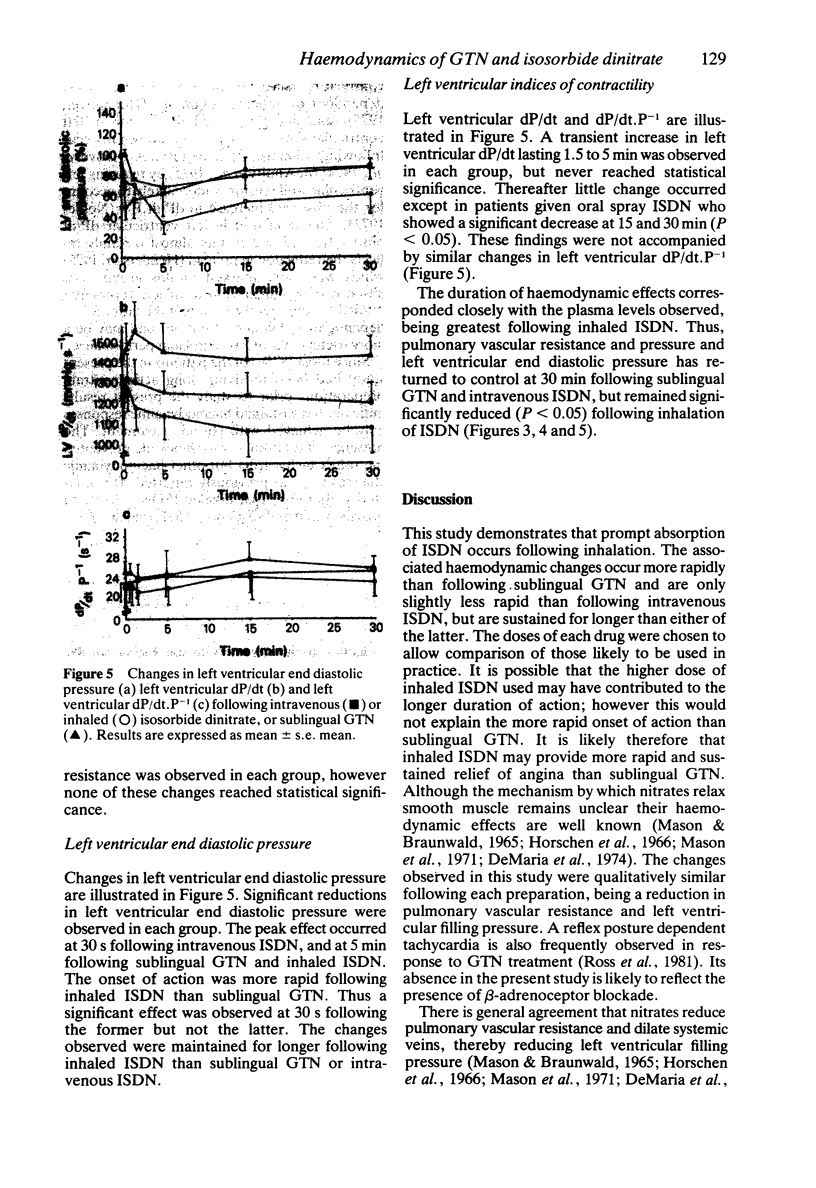
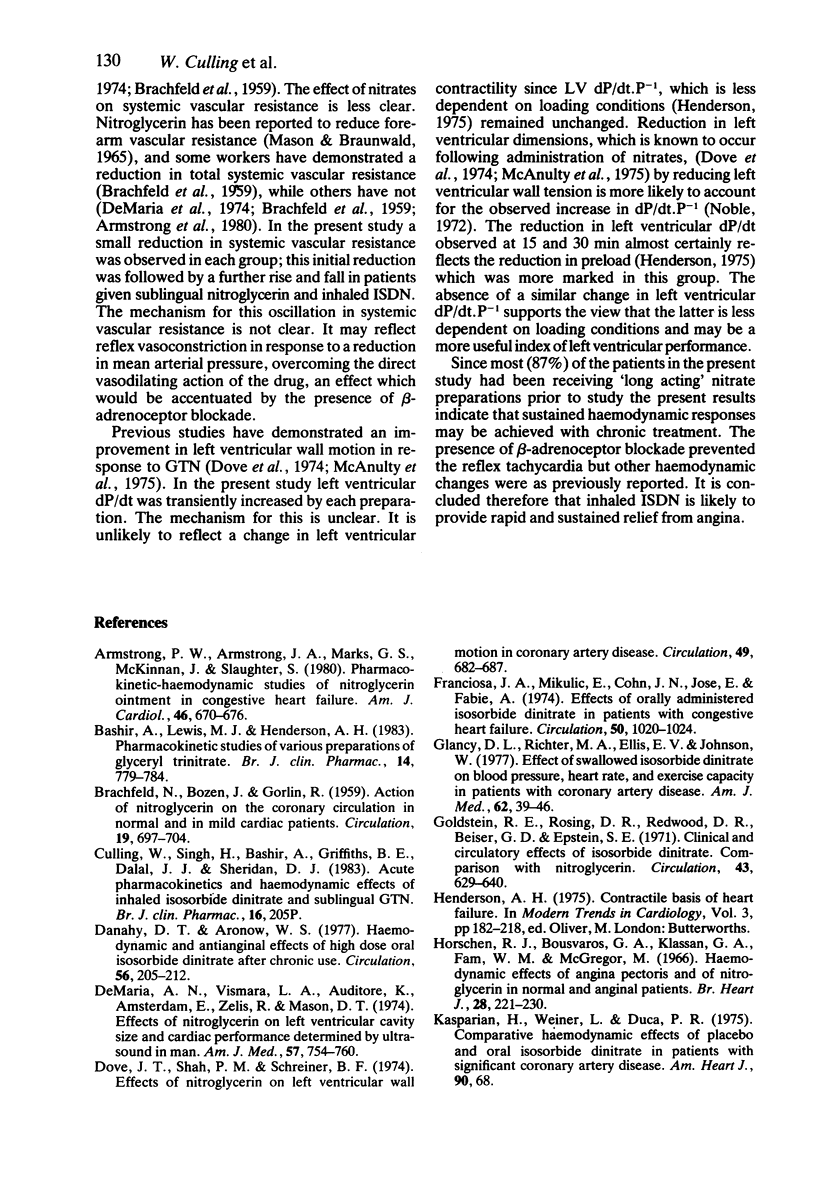
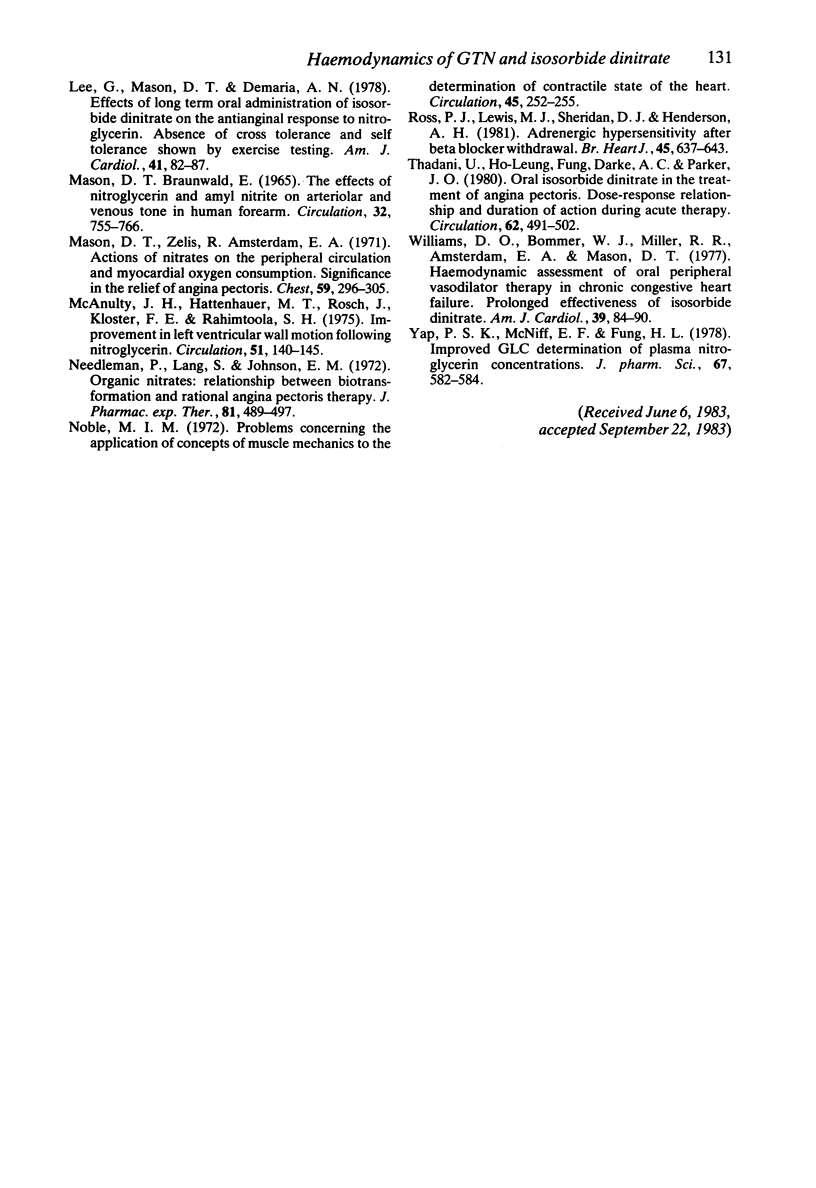
Selected References
These references are in PubMed. This may not be the complete list of references from this article.
- Armstrong P. W., Armstrong J. A., Marks G. S. Pharmacokinetic-hemodynamic studies of nitroglycerin ointment in congestive heart failure. Am J Cardiol. 1980 Oct;46(4):670–676. doi: 10.1016/0002-9149(80)90519-6. [DOI] [PubMed] [Google Scholar]
- BRACHFELD N., BOZER J., GORIN R. Action of nitroglycerin on the coronary circulation in normal and in mild cardiac subjects. Circulation. 1959 May;19(5):697–704. doi: 10.1161/01.cir.19.5.697. [DOI] [PubMed] [Google Scholar]
- Bashir A., Lewis M. J., Henderson A. H. Pharmacokinetic studies of various preparations of glyceryl trinitrate. Br J Clin Pharmacol. 1982 Dec;14(6):779–784. doi: 10.1111/j.1365-2125.1982.tb02036.x. [DOI] [PMC free article] [PubMed] [Google Scholar]
- Danahy D. T., Aronow W. S. Hemodynamics and antianginal effects of high dose oral isosorbide dinitrate after chronic use. Circulation. 1977 Aug;56(2):205–212. doi: 10.1161/01.cir.56.2.205. [DOI] [PubMed] [Google Scholar]
- DeMaria A. N., Vismara L. A., Auditore K., Amsterdam E. A., Zelis R., Mason D. T. Effects of nitroglycerin on left ventricular cavitary size and cardiac performance determined by ultrasound in man. Am J Med. 1974 Nov;57(5):754–760. doi: 10.1016/0002-9343(74)90849-3. [DOI] [PubMed] [Google Scholar]
- Dove J. T., Shah P. M., Schreiner B. F. Effects of nitroglycerin on left ventricular wall motion in coronary artery disease. Circulation. 1974 Apr;49(4):682–687. doi: 10.1161/01.cir.49.4.682. [DOI] [PubMed] [Google Scholar]
- Franciosa J. A., Mikulic E., Cohn J. N., Jose E., Fabie A. Hemodynamic effects of orally administered isosorbide dinitrate in patients with congestive heart failure. Circulation. 1974 Nov;50(5):1020–1024. doi: 10.1161/01.cir.50.5.1020. [DOI] [PubMed] [Google Scholar]
- Glancy D. L., Richter M. A., Ellis E. V., Johnson W. Effect of swallowed isosorbide dinitrate on blood pressure, heart rate and exercise capacity in patients with coronary artery disease. Am J Med. 1977 Jan;62(1):39–46. doi: 10.1016/0002-9343(77)90347-3. [DOI] [PubMed] [Google Scholar]
- Goldstein R. E., Rosing D. R., Redwood D. R., Beiser G. D., Epstein S. E. Clinical and circulatory effects of isosorbide dinitrate. Comparison with nitroglycerin. Circulation. 1971 May;43(5):629–640. doi: 10.1161/01.cir.43.5.629. [DOI] [PubMed] [Google Scholar]
- Hoeschen R. J., Bousvaros G. A., Klassen G. A., Fam W. M., McGregor M. Haemodynamic effects of angina pectoris, and of nitroglycerin in normal and anginal subjects. Br Heart J. 1966 Mar;28(2):221–230. doi: 10.1136/hrt.28.2.221. [DOI] [PMC free article] [PubMed] [Google Scholar]
- Kasparian H., Wiener L., Duca P. R., Gottlieb R. S., Brest A. N. Comparative hemodynamic effects of placebo and oral isosorbide dinitrate in patients with significant coronary artery disease. Am Heart J. 1975 Jul;90(1):68–74. doi: 10.1016/0002-8703(75)90258-6. [DOI] [PubMed] [Google Scholar]
- Lee G., Mason D. T., De Maria A. N. Effects of long-term oral administration of isosorbide dinitrate on the antianginal response to nitroglycerin. Absence of nitrate cross-tolerance and self-tolerance shown by exercise testing. Am J Cardiol. 1978 Jan;41(1):82–87. doi: 10.1016/0002-9149(78)90136-4. [DOI] [PubMed] [Google Scholar]
- Mason D. T., Braunwald E. The effects of nitroglycerin and amyl nitrite on arteriolar and venous tone in the human forearm. Circulation. 1965 Nov;32(5):755–766. doi: 10.1161/01.cir.32.5.755. [DOI] [PubMed] [Google Scholar]
- Mason D. T., Zelis R., Amsterdam E. A. Actions of the nitrites on the peripheral circulation and myocardial oxygen consumption: significance in the relief of angina pectoris. Chest. 1971 Mar;59(3):296–305. doi: 10.1378/chest.59.3.296. [DOI] [PubMed] [Google Scholar]
- McAnulty J. H., Hattenhauer M. T., Rösch J., Kloster F. E., Rahimtoola S. H. Improvement in left ventricular wall motion following nitroglycerin. Circulation. 1975 Jan;51(1):140–145. doi: 10.1161/01.cir.51.1.140. [DOI] [PubMed] [Google Scholar]
- Needleman P., Lang S., Johnson E. M., Jr Organic nitrates: relationship between biotransformation and rational angina pectoris therapy. J Pharmacol Exp Ther. 1972 Jun;181(3):489–497. [PubMed] [Google Scholar]
- Noble M. I. Problems concerning the application of concepts of muscle mechanics to the determination of the contractile state of the heart. Circulation. 1972 Feb;45(2):252–255. doi: 10.1161/01.cir.45.2.252. [DOI] [PubMed] [Google Scholar]
- Ross P. J., Lewis M. J., Sheridan D. J., Henderson A. H. Adrenergic hypersensitivity after beta-blocker withdrawal. Br Heart J. 1981 Jun;45(6):637–642. doi: 10.1136/hrt.45.6.637. [DOI] [PMC free article] [PubMed] [Google Scholar]
- Thadani U., Fung H. L., Darke A. C., Parker J. O. Oral isosorbide dinitrate in the treatment of angina pectoris. Dose-response relationship and duration of action during acute therapy. Circulation. 1980 Sep;62(3):491–502. doi: 10.1161/01.cir.62.3.491. [DOI] [PubMed] [Google Scholar]
- Williams D. O., Bommer W. J., Miller R. R., Amsterdam E. A., Mason D. T. Hemodynamic assessment of oral peripheral vasodilator therapy in chronic congestive heart failure: prolonged effectiveness of isosorbide dinitrate. Am J Cardiol. 1977 Jan;39(1):84–90. doi: 10.1016/s0002-9149(77)80016-7. [DOI] [PubMed] [Google Scholar]
- Yap P. S., McNiff E. F., Fung H. L. Improved GLC determination of plasma nitroglycerin concentrations. J Pharm Sci. 1978 Apr;67(4):582–584. doi: 10.1002/jps.2600670445. [DOI] [PubMed] [Google Scholar]


